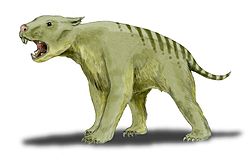| Nimbadon Temporal range: | |
|---|---|
 | |
| Composite N. lavarackorum skeleton from the Riversleigh site | |
 | |
| N. lavarackorum mother and juvenile (reconstruction) by Peter Schouten | |
| Scientific classification | |
| Kingdom: | Animalia |
| Phylum: | Chordata |
| Class: | Mammalia |
| Infraclass: | Marsupialia |
| Order: | Diprotodontia |
| Superfamily: | † Diprotodontoidea |
| Genus: | † Nimbadon Hand, Archer, Godthelp, Rich & Pledge, 1993. [1] |
| Species | |
†Nimbadon lavarackorum Contents | |
Nimbadon is an extinct genus of marsupial, that lived from the Oligocene to the Miocene. [1] Many fossils have been found in the Riversleigh World Heritage property in north-western Queensland. It is thought to have an arboreal lifestyle. [2]
In 1990, skulls were unearthed in a previously unknown cave in the region. Researchers estimate that the first species of Nimbadon first appeared around 25 million years ago [1] and went extinct around 12 million years ago, perhaps from climate change-induced habitat loss.

